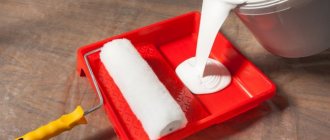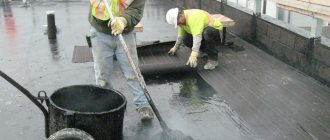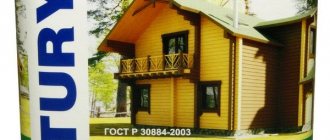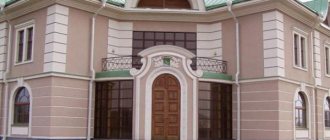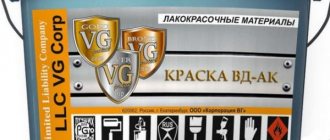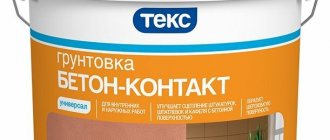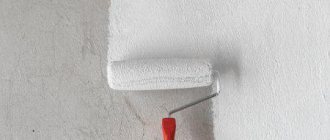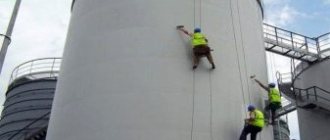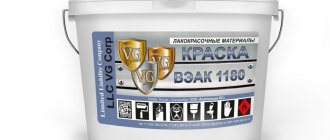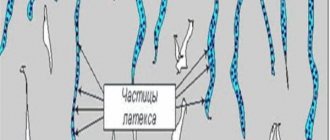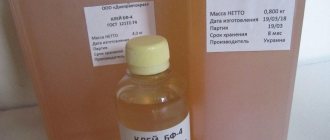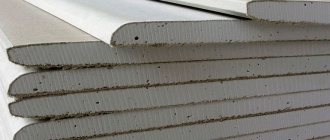1.TECHNICAL REQUIREMENTS
1.1. Primer GF-021 must be manufactured in accordance with the requirements of this standard according to the recipe and technological regulations approved in the prescribed manner.
1.2. The GF-021 primer is applied to the surface by pneumatic and airless spraying, spraying in an electric field, jet pouring, dipping, or brush.
1.3. Before use, the primer is diluted to working viscosity with solvent (GOST 10214 or GOST 1928), xylene (GOST 9949 or GOST 9410), or a mixture of one of these solvents with white spirit (nefras-SCh-155/200) according to GOST 3134 in a ratio of mass 1:1.
To paint products by spraying in an electric field, the primer is diluted with RE-4V thinner (GOST 18187).
(Changed edition, Amendment No. 1).
1.4. The primer must comply with the requirements and standards specified in table. 1.
Table 1
| Indicator name | Norm | Test method |
| 1. Primer film color | Red-brown, shade not standardized | According to clause 4.3 |
| 3. Appearance of the film | After drying, the film should be smooth, uniform, matte or semi-gloss | According to clause 4.3 |
| 3. Conditional viscosity at (20.0±0.5)°С according to the VZ-4 viscometer, s, not less | 45 | According to GOST 8420 |
| 4. Degree of primer dilution with solvent, %, no more | 20 | According to clause 4.4 |
| 5. Mass fraction of non-volatile substances, % | 54-60 | According to GOST 17537, section. 1 and clause 4.5 of this standard |
| 6. Degree of grinding, microns, no more | 40 | According to GOST 6589 |
| 7. Drying time to degree 3, no more at (105±5)°C, min | 35 | According to GOST 19007 |
| (20±2) °С, h | 24 | |
| 8. Film hardness according to the pendulum device M-3, conventional units, not less | 0,35 | According to GOST 5233 |
| 9. Film elasticity when bending, mm, no more | 1 | According to GOST 6806 |
| 10. Film strength upon impact on a U-1 type device, cm, not less | 50 | According to GOST 4765 |
| 11. Film adhesion, points, no more | 1 | According to GOST 15140, section. 2 |
| 12. Film resistance to static action of 3% sodium chloride solution, h, not less | 24 | According to GOST 9.403, section. 2 and clause 4.7 of this standard |
| 13. The ability of the film to be sanded | When sanding, the film should form a smooth surface and not stain the sandpaper. | According to clause 4.8 |
| 14. Film resistance to nitro enamel | There should be no peeling, wrinkling, or cracking of the nitro enamel film applied to the primer | According to clause 4.9 |
| 15. Film resistance to static effects of mineral oil at (20±2)°C, h, not less | 48 | According to GOST 9.403, section. 2 and clause 4.10 of this standard |
| 16. Delamination, ml, no more | 5 | According to clause 4.11 |
Note. The formation of an easily stirred sediment during storage is allowed, as well as an increase in the degree of dilution of the primer, if after thorough stirring and dilution the primer meets the requirements of this standard.
(Changed edition, Amendment No. 1, 2).
Practical tips for use
Before you buy GF-021 primer, you should at least roughly calculate the required amount, based on the area that we will prime. The calculation is simple: we calculate the total area of surfaces intended for processing. We multiply the resulting area by the possible soil consumption (100 g/m2). We get the amount of soil we need in grams.
According to the manufacturers, the primer is guaranteed to be well stored in closed packaging for at least 6 months from the date of production. Although practice shows that paintwork materials of this type can be stored for a year or more, when purchasing the material you should make sure that it is “fresh”.
Before treating with a primer, it is necessary to prepare the surface, namely cleaning it from dust and dirt, from rust and old coating, as well as degreasing. The most convenient way to degrease the surface is with white spirit. This solvent degreases well, in addition, it is a solvent for the primer itself and is convenient for cleaning the tool after work.
Before starting work, the GF-021 primer is thoroughly mixed, if necessary, diluted with a solvent. Primer GF-021 is diluted with xylene, solvent or a mixture of one of them with white alcohol (1:1). Since the primer is quite liquid, it is more convenient to use a spray gun to treat the surface, but you can also prime using a simple brush or roller (2 layers). In addition, the primer is applied by dipping, as well as by airless spraying, electric field spraying and even jet spraying. Work must be carried out at room temperature.
Before starting work in a confined space, all windows must be opened, since the GF-021 primer has a rather pungent and unpleasant odor. In addition, vapors of organic solvents accumulating in a confined space can cause poisoning and headaches. This soil is not the fastest drying one. After application, the coating dries in about 12 hours, as indicated by the manufacturers. However, drying time is at least 24 hours. Therefore, it is better to take your time and wait for the coating to dry completely so that the top paint applies as smoothly and efficiently as possible. Sometimes it is necessary to re-prime the surface, for example when priming porous surfaces such as wood. In this case, you can get a smoother surface by processing it a second time.
In conclusion, a little about the shortcomings of our primer. There are very few of them, but this is also worth knowing about.
- Many paints curl up when in contact with undried GF-021 primer. It is easy to turn this disadvantage into an advantage - do not rush to apply the finishing coating, wait until the soil dries completely.
- The soil does not penetrate deeply into the treated surface. Therefore, GF-021 primer is not used for fixing loose and crumbling surfaces. There are special purpose primers for this – penetrating primers.
So, we have figured out the basic performance properties and technical characteristics of the GF-021 primer, as well as methods of its use. Now it is clear that a primer is simply necessary for those who want to make high-quality, beautiful and long-lasting repairs, paint iron gates, doors, walls, or even just hang wallpaper. The quality and price of the domestically produced primer GF-021 allows it to successfully replace imported analogues, which makes this material very attractive to us, consumers.
User reviews.
Primer GF-021 has many positive reviews. It is ideal for priming metal and wooden surfaces and is used to prepare the surface before applying various types of enamels (GF, PF, FL, EF, etc.)
“We used GF-021 primer to paint a fairly large section of pipe. This pipe was new and did not need to be sanded. After priming, we painted it. Considering that the pipe is very often exposed to rain, snow, or just frost, it looks excellent (there is no hint of corrosion).”
“We used red-brown GF-021 at industrial facilities - the characteristics are excellent. Both metal and wooden surfaces were treated (for fire safety purposes). After 5 years, the primer paint is still holding up great, no rust or areas of peeling paint.”
“I praise the GF-021 red-brown primer. Before painting the gas pipe, my husband coated its bends and joints with a primer - this is where rust can appear. At first I didn't believe that the brown primer wouldn't show through under the yellow paint. It turned out I was wrong. I just had to paint the primed areas twice.”
SAFETY REQUIREMENTS
2.1. Primer GF-021 is a flammable and toxic material, which is due to the properties of the solvents included in the primer (Table 2).
Solvent vapors included in the primer have an irritating effect on the mucous membranes of the eyes, respiratory tract and skin.
table 2
| Component name | Maximum permissible concentration in the air of the working area of industrial premises, mg/m3, | Temperature, °C | Concentration limits of ignition,% (by volume) | Hazard Class | |
| flashes | spontaneous combustion | ||||
| Xylene | 50 | Not lower than 24 | Not higher than 450 | 1,0-6,0 | 3 |
| Solvent | 50 | 22-36 | 464-535 | 1,02 | 4 |
| White spirit (nefras-SCH-155/200) | 100 | 33 | 270 | 1,4-6,0 | 4 |
(Changed edition, Amendment No. 1).
2.2. During production, use, and testing of the primer, fire safety and industrial sanitation requirements in accordance with GOST 12.3.005 must be observed.
2.3. All work related to the manufacture, use and testing of the primer must be carried out in workshops equipped with supply and exhaust ventilation and fire safety equipment in accordance with GOST 12.3.005.
2.4. Precautionary measures: sealing production equipment, providing workers with personal protective equipment that meets the requirements of GOST 12.4.011.
2.5. Coating with a primer after drying does not have a harmful effect on the human body.
2.6. Monitoring the state of the air environment - in accordance with GOST 12.1.007 and GOST 17.2.3.02.
(Introduced additionally, Amendment No. 1).
TEST METHODS
4.1. Sampling - according to GOST 9980.2.
4.2. Preparing for the test
Plates for applying primer are prepared in accordance with GOST 8832, section. 3.
Film hardness is determined on glass for photographic plates 9´12-1.2 according to TU 6-43-0205133-03-91.
The elasticity of the film during bending is determined on plates made of black tin according to the technical documentation, 20 x 150 mm in size, 0.25 - 0.28 mm thick.
The remaining indicators are determined on plates made of steel grades 08 kp and 08 ps according to GOST 16523, size 70´150 mm, thickness 0.8 - 0.9 mm.
Conditional viscosity, degree of dilution, mass fraction of non-volatile substances and degree of grinding are determined in undiluted primer.
When determining other indicators, the primer is thoroughly mixed, diluted to a viscosity of 22 - 24 s using a Tina VZ-4 viscometer with a nozzle diameter of (4.000 ± 0.015) mm at (20.0 ± 0.5) °C with solvent or xylene, filtered through a sieve with mesh No. 01-05 (GOST 6613) and applied with a paint sprayer to the prepared plates.
When determining the resistance of the film to the static effects of a 3% solution of sodium chloride and mineral oil, the primer is applied in two layers on both sides of the plate.
Drying each layer at (105 ± 5) °C for 35 minutes. When determining other indicators, the primer is applied in one layer.
Drying a single-layer film at (105 ± 5) °C - for 35 minutes.
The thickness of a single-layer dried film should be 15-20 microns, two-layer - 30-40 microns.
After drying, the plates are kept for 3 hours at (20 ± 2) °C before testing.
4.1, 4.2. (Changed edition, Amendment No. 1).
4.3. The color and appearance of the primer film is determined visually in natural diffused light.
4.4.Determination of the degree of dilution of the primer with a solvent
120 - 130 g of primer is weighed with an error of no more than 0.1 g and diluted with solvent or xylene to a viscosity of 22 - 24 s using a VZ-4 type viscometer with a nozzle diameter of (4.000 ± 0.015) mm at (20.0 ± 0.5) °C.
Dilution rate ( X
) as a percentage is calculated using the formula
,
where t -
primer mass, g;
m
1 - mass of solvent used to dilute the primer, g.
4.5. The mass fraction of non-volatile substances is determined according to GOST 17537.
A sample weighing (2.0 ± 0.2) g is placed in a drying oven and maintained at a temperature of (140 ± 2) °C. The first weighing is carried out after 1 hour, subsequent weighings are carried out every 30 minutes until the weight remains constant.
It is possible to determine the mass fraction of non-volatile substances under an infrared lamp at a temperature of (142 ± 2) °C. In case of disagreement in the assessment of this indicator, the final result is the determination in a drying cabinet.
4.4, 4.5. (Changed edition, Amendment No. 1).
4.6. (Deleted, Amendment No. 1).
4.7. Film resistance to static action of 3% sodium chloride solution
Before inspection, the samples are kept in air at (20 ± 2) °C for 1 hour, then examined with the naked eye.
4.8. Determination of the sandability of a primer film
The plate with the dried film prepared according to clause 4.2 is sanded with sandpaper with a grain size of 4 - 5 according to GOST 6456 or GOST 10054.
4.7, 4.8. (Changed edition, Amendment No. 1).
4.9.
Determination of the resistance of the film to the action of nitro enamel
On the primer film prepared according to clause 4.2, 10 minutes after drying, three layers of enamel NTs-11 (GOST 9198) or NTs-25 (GOST 5406) are applied with a paint sprayer.
Each layer of nitro enamel is dried at (20 ± 2) °C for 10 minutes.
The thickness of each enamel layer should be 20 - 25 microns.
The enamel film should not peel off, wrinkle, or crack.
4.10. Film resistance to static effects of mineral oil
After the test, the plate is kept in air at (20 ± 2) °C for 2 hours and examined with the naked eye.
(Changed edition, Amendment No. 1).
4.11. Delamination Definition
A glass graduated cylinder 2 - 100 according to GOST 1770 is filled with diluted primer to the 100 cm3 mark and left at rest at a temperature of (20 ± 2) °C for 24 hours, after which the volume of the separated layer in the upper part of the cylinder is determined.
(Introduced additionally, Amendment No. 1).
Technical characteristics and purpose
Primer GF-021 is used for protective painting of various surfaces. It is designed for metal and wood, allowing you to protect the material from destruction, environmental influences, corrosion, various microorganisms and the like. The surface is covered with a thin protective layer, completely isolating it from any impact.
The use of such a base allows you to increase the life of paint and varnish coatings, as well as reduce their consumption. It increases surface adhesion and allows you to apply enamel to the prepared base, ensuring reliable adhesion.
The primer is produced in two colors - red-brown and light gray. The shade may vary depending on the composition and production features. The surface after coating becomes uniform, smooth and matte.
Important! The surface may have a semi-gloss appearance. This depends on the application conditions and the characteristics of the coating.
Main technical characteristics of the primer GF-021:
- Conditional viscosity according to the viscometer: 45 s.
- Mass fraction of non-volatile substances: 54-60%.
- Grinding degree: no more than 40 microns.
- Drying time to degree 3: 12 hours at 20 °C.
- Elasticity when bending: no more than 1 mm.
- Film adhesion: no more than 1 point.
- Density: 1.25-1.3 kg/l.
- Shelf life: 2 years.
The technical characteristics fully comply with those specified, but are preserved only if the substance is properly stored. This storage is called keeping it in a closed factory container. The place where the containers are placed should have an average level of humidity and not be exposed to direct sunlight. The substance is resistant to sub-zero temperatures and can withstand even -20 °C.
The primer tolerates sanding and, during normal storage, forms a smooth surface without peeling. This should be used when applying paint and varnish coatings to it.
PACKAGING, LABELING, TRANSPORTATION AND STORAGE
5.1. Packaging - according to GOST 9980.3, group 5.
5.2. Marking - according to GOST 9980.4.
The purpose, method of application and precautions for handling retail primer are specified in the mandatory appendix.
5.3. Transportation and storage - in accordance with GOST 9980.5. The transport container must additionally be marked with a danger sign in accordance with GOST 19433, class 3, drawing. 3, classification code 3313 and manipulation sign “Sealed packaging” according to GOST 14192.
Sec. 5. (Changed edition, Amendment No. 1).
